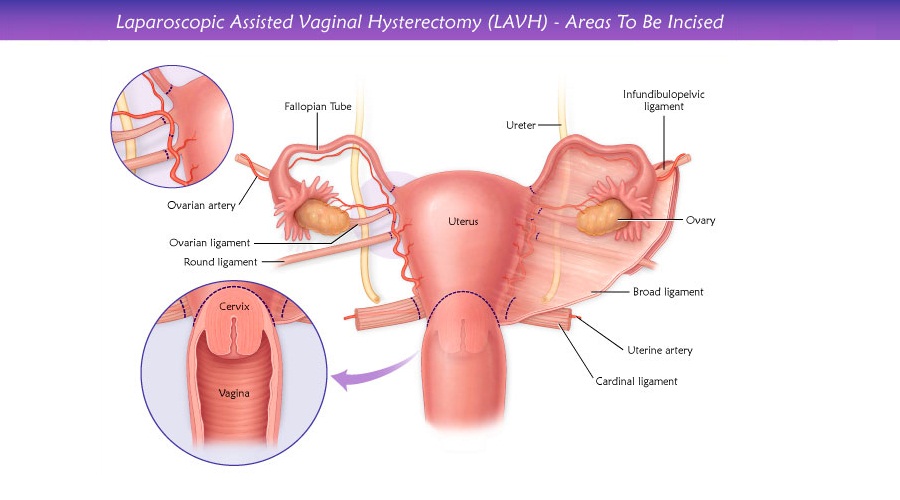Laparoscopically Assisted Vaginal Hysterectomy (LAVH) is a procedure using laparoscopic surgical techniques and instruments to remove the uterus (womb) and/or tubes and ovaries through the vagina.
Its greatest benefit is the potential to convert what would have been an abdominal hysterectomy into a vaginal hysterectomy. An abdominal hysterectomy requires both a vaginal incision and a four to six inch long incision in the abdomen, which is associated with greater post-operative discomfort and a longer recovery period than for a vaginal procedure. Another advantage of the LAVH may be the removal of the tubes and ovaries which on occasion may not be easily removed with a vaginal hysterectomy.
This does not mean that all hysterectomies could or should be done by LAVH. There are certain conditions that will necessitate abdominal or vaginal hysterectomy. In fact a vaginal hysterectomy by itself, if indicated, is less time consuming, less expensive, and can be less dangerous. When LAVH is performed, several small abdominal incisions are made. Through these small incisions slender metal tubes known as “trocars” are inserted. They provide passage for a laparoscope (which is like a tiny telescope) and other microsurgical tools.
A camera attached to the laparoscope provides a continuous image that is magnified and projected onto a television screen. It provides the view by which the surgeon operates.
The uterus is detached from the ligaments that attach it to other pelvic structures using laparoscopic tools, electro-coagulation or a laser. Adhesions may have to be freed and, if the tubes and ovaries are to be removed, they are detached from their ligaments and blood supply. They then can be removed with the uterus through an incision made in the vagina. Since the incisions are small, the scarring and pain from LAVH is often less than that associated with abdominal hysterectomy.
This approach is best for benign conditions that lead to hysterectomy when the uterus is not too large. It is often the best approach for uterine prolapse. With a vaginal hysterectomy, you will not have any external scarring. You may also recover more quickly because you are not waiting for a large abdominal incision to heal.
However, vaginal hysterectomy gives the surgeon less room to operate and no real opportunity to view your pelvic organs.
Laparoscopically assisted vaginal hysterectomy offers an alternative. It is a combined procedure that can remove the uterus vaginally when it otherwise would require a large abdominal incision. The surgeon makes a small incision in your lower abdomen to insert a thin device (laparoscope) that allows the surgical team to see inside your abdomen. Your surgeon uses specially crafted surgical instruments to detach the uterus and then removes it through your vagina. This approach requires the longest operating time.
